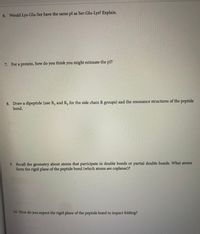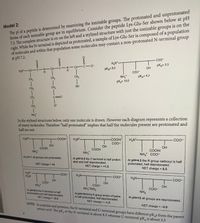
Biochemistry
9th Edition
ISBN: 9781319114671
Author: Lubert Stryer, Jeremy M. Berg, John L. Tymoczko, Gregory J. Gatto Jr.
Publisher: W. H. Freeman
expand_more
expand_more
format_list_bulleted
Concept explainers
Topic Video
Question

Transcribed Image Text:6. Would Lys-Glu-Ser have the same pl as Ser-Glu-Lys? Explain.
7. For a protein, how do you think you might estimate the pI?
8. Draw a dipeptide (use R, and R, for the side chain R groups) and the resonance structures of the peptide
bond.
9. Recall the geometry about atoms that participate in double bonds or partial double bonds. What atoms
form the rigid plane of the peptide bond (which atoms are coplanar)?
10. How do you expect the rigid plane of the peptide bond to impact folding?

Transcribed Image Text:The pl of a peptide is determined by examining the ionizable groups. The protonated and unprotonated
forms of each ionizable group are in equilibrium. Consider the peptide Lys-Glu-Ser shown below at pH
7.2. The complete structure is on on the left and a stylized structure with just the ionizable groups is on the
right. While the N-terminal is depicted as protonated, a sample of Lys-Glu-Ser is composed ofa population
of molecules and within that population some molecules may contain a non-protonated N-terminal group
at pH 7.2.
Model 2:
COO-
H,N*.
pK,= 3.5
N-CH-C N CH- -0-
H.
OH
:-
pK= 8.5
H,N*-CH-C-
H.
COO-
NH;*
pK= 10.0
CH2
pK=4.2
CH2
CH2
一
CH2
OH
CH2
CH2
C0
CH2
NH,*
In the stylized structures below, only one molecule is drawn. However each diagram represents a collection
of many molecules. Therefore "half protonated" implies that half the molecules present are protonated and
half are not.
HạN-
COOH
H3N*-
-COOH/
COO-
H3N-
COO-
OH
OH
COOH
NH3
COOH
NH3
СООН
NH3 COO-
At pH=1 all groups are protonated.
At pH=3.5 the C terminal is half proton-
ated and half deprotonated.
At pH=4.2 the R group carboxyl is half
protonated, half deprotonated.
NET charge = 0.5
NET charge = +2
NET charge = +1.5
H3N*
/H,N
COO-
H2N
COO-
H2N-
OH
COO-
CO0-
NH,
OH
COO-
OH
NH3 /NH2
COO-
At pH=8.5 the N terminal is half
protonated and half deprotonated.
NH2
At pH=10.0 the R group amino of lysine
is half protonated, half deprotonated.
NET charge -0.5
At pH=12 all groups are deprotonated.
%3D
NET charge = -1.5
NOTE: In peptides and proteins, the N-terminal and C-terminal groups have different pK,s from the parent
amino acid. The pK, of the N-terminal is about 8.5 whereas C-terminal pK, is about 3.5
NET charge =-2.0
Expert Solution
This question has been solved!
Explore an expertly crafted, step-by-step solution for a thorough understanding of key concepts.
This is a popular solution
Trending nowThis is a popular solution!
Step by stepSolved in 3 steps with 2 images

Follow-up Questions
Read through expert solutions to related follow-up questions below.
Follow-up Question
Is there a reason why you divided the pKa's by 2 when determining the pI?
Solution
by Bartleby Expert
Follow-up Questions
Read through expert solutions to related follow-up questions below.
Follow-up Question
Is there a reason why you divided the pKa's by 2 when determining the pI?
Solution
by Bartleby Expert
Knowledge Booster
Learn more about
Need a deep-dive on the concept behind this application? Look no further. Learn more about this topic, biochemistry and related others by exploring similar questions and additional content below.Similar questions
- In the following polypeptide, which amino acid would be participating in hydrogen bonding with alanine, given this sequence forms an alpha helix? Please write out the full amino acid name, not the abbreviation. Met-Ala-Leu-Glu-Lys-Thr-Leu-Valarrow_forwardс" CH2 CH2 "НaN H с. CH С" CH Нзс CHз ZI о-оarrow_forward1. Amino Acid 1 = W + X = 1 Draw amino acid 1 at a low pH a) As the D Fisher Projection Name of amino acid 1: b) As the S isomer: Argininearrow_forward
- 4. You're working on a structure of a protein and its folding. You think that the interaction between Asp123 and Arg29 is important in determining the structure of the protein. a) What type of amino acid is Asp (acidic, basic, hydrophobic, or polar)? b) What type of amino acid is Arg (acidic, basic, hydrophobic, or polar)? c) What is the strongest interaction that can form between Asp123 and Arg29? You create a mutant Arg29> Lys d) What type of amino acid is Lys (acidic, basic, hydrophobic, or polar)? e) Would you expect this substitution mutation to cause major folding problems? Why or why not? You create mutant Arg29> Glu you discover that this mutant is unable to fold properly, so the protein is nonfunctional. f What type of amino acid is Glu (acidic, basic, hydrophobic, or polar)? g) How does this amino acid substitution cause the protein to fold incorrectly? You find another mutant that also as the same Arg29> Glu mutation. However, this mutant protein įs able to fold normally.…arrow_forward+H₂N-CH-COO™ T CH₂ I CH₂ 1 CH₂ I +H₂N-CH₂ A. O amino acid C amino acid D O amino acid E amino acid B +H₂N-CH-COO™ I CH₂ I CH₂ 1 O amino acid A C=0 B. If the pH decreases enough, this amino acid will become protonated and could contribute to the denaturation of the protein. +H₂N-CH-COO™ 1 CH₂ I OH C. +H₂N-CH-COO™ CH H₂C CH3 D.arrow_forward6) Circle one amino acid in this peptide (hint: draw lines between not through atoms). Kahalalide F NH HN HO NH HN HNarrow_forward
arrow_back_ios
arrow_forward_ios
Recommended textbooks for you
 BiochemistryBiochemistryISBN:9781319114671Author:Lubert Stryer, Jeremy M. Berg, John L. Tymoczko, Gregory J. Gatto Jr.Publisher:W. H. Freeman
BiochemistryBiochemistryISBN:9781319114671Author:Lubert Stryer, Jeremy M. Berg, John L. Tymoczko, Gregory J. Gatto Jr.Publisher:W. H. Freeman Lehninger Principles of BiochemistryBiochemistryISBN:9781464126116Author:David L. Nelson, Michael M. CoxPublisher:W. H. Freeman
Lehninger Principles of BiochemistryBiochemistryISBN:9781464126116Author:David L. Nelson, Michael M. CoxPublisher:W. H. Freeman Fundamentals of Biochemistry: Life at the Molecul...BiochemistryISBN:9781118918401Author:Donald Voet, Judith G. Voet, Charlotte W. PrattPublisher:WILEY
Fundamentals of Biochemistry: Life at the Molecul...BiochemistryISBN:9781118918401Author:Donald Voet, Judith G. Voet, Charlotte W. PrattPublisher:WILEY BiochemistryBiochemistryISBN:9781305961135Author:Mary K. Campbell, Shawn O. Farrell, Owen M. McDougalPublisher:Cengage Learning
BiochemistryBiochemistryISBN:9781305961135Author:Mary K. Campbell, Shawn O. Farrell, Owen M. McDougalPublisher:Cengage Learning BiochemistryBiochemistryISBN:9781305577206Author:Reginald H. Garrett, Charles M. GrishamPublisher:Cengage Learning
BiochemistryBiochemistryISBN:9781305577206Author:Reginald H. Garrett, Charles M. GrishamPublisher:Cengage Learning Fundamentals of General, Organic, and Biological ...BiochemistryISBN:9780134015187Author:John E. McMurry, David S. Ballantine, Carl A. Hoeger, Virginia E. PetersonPublisher:PEARSON
Fundamentals of General, Organic, and Biological ...BiochemistryISBN:9780134015187Author:John E. McMurry, David S. Ballantine, Carl A. Hoeger, Virginia E. PetersonPublisher:PEARSON

Biochemistry
Biochemistry
ISBN:9781319114671
Author:Lubert Stryer, Jeremy M. Berg, John L. Tymoczko, Gregory J. Gatto Jr.
Publisher:W. H. Freeman

Lehninger Principles of Biochemistry
Biochemistry
ISBN:9781464126116
Author:David L. Nelson, Michael M. Cox
Publisher:W. H. Freeman

Fundamentals of Biochemistry: Life at the Molecul...
Biochemistry
ISBN:9781118918401
Author:Donald Voet, Judith G. Voet, Charlotte W. Pratt
Publisher:WILEY

Biochemistry
Biochemistry
ISBN:9781305961135
Author:Mary K. Campbell, Shawn O. Farrell, Owen M. McDougal
Publisher:Cengage Learning

Biochemistry
Biochemistry
ISBN:9781305577206
Author:Reginald H. Garrett, Charles M. Grisham
Publisher:Cengage Learning

Fundamentals of General, Organic, and Biological ...
Biochemistry
ISBN:9780134015187
Author:John E. McMurry, David S. Ballantine, Carl A. Hoeger, Virginia E. Peterson
Publisher:PEARSON